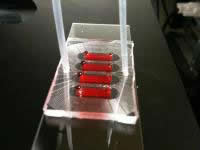Novel microfluidic HIV test is quick and cheap
Microfluidic device uses antibodies to 'capture' white blood cells called T cells affected by HIV
16-Jul-2010 -  UC Davis
biomedical engineer Prof. Alexander Revzin has developed a "lab on a chip" device for HIV testing. Revzin's microfluidic device uses antibodies to "capture" white blood cells
called T cells that are affected by HIV. In addition to physically binding these cells the test detects the types and levels of inflammatory proteins (cytokines) released by the cells. UC Davis
biomedical engineer Prof. Alexander Revzin has developed a "lab on a chip" device for HIV testing. Revzin's microfluidic device uses antibodies to "capture" white blood cells
called T cells that are affected by HIV. In addition to physically binding these cells the test detects the types and levels of inflammatory proteins (cytokines) released by the cells.
Revzin's team collaborated with UCLA electrical engineer Prof. Aydogan Ozcan to integrate an antibody microarray with a lensfree holographic imaging device that takes
only seconds to count the number of captured cells and amount of secreted cytokine molecules. The test returns results six to twelve times faster than traditional approaches and tests six
parameters simultaneously, based on a small blood sample. The Revzin team published the results of their experiments in the May 2010 issue of Analytical Chemistry.
With further refinements, the test will have wide potential use for multi-parametric blood analysis performed at the point of care in the developing world and
resource-poor areas. Its affordability will also make it an attractive option in wealthier areas. Revzin has filed for a patent and is looking for ways to bring his test into clinical use.
"In addition to HIV testing and monitoring, this device will be useful for blood transfusions, where the safety of blood is frequently in question," Revzin says.
The most accurate and effective way to diagnose and monitor HIV infection involves counting two types of T-cells, calculating the ratio between the two types of T-cells, and measuring cytokines.
Scientists do this using a method called flow cytometry that requires an expensive machine and several highly trained specialists. Healthcare workers and AIDS activists in the developing world
have called for less expensive, more easily performed tests.
"While the point of care field focuses on detection of single parameter (e.g. CD4 counts), we believe that the simplicity of the test need not compromise information content. So, we set
out to develop a test that could be simple and inexpensive but would provide several parameters based on a single injection of a small blood volume," explains Revzin.
The HIV test addresses two distinct challenges of blood analysis: 1) capturing the desired cell type from blood, which contains multiple cell types, and 2) connecting the desired blood cell
type with secreted cytokines. The test consists of polymer film imprinted with an array of miniature spots. Each spot contains antibodies specific to the two kinds of T-cells (CD4 and CD8)
and three types of cytokines printed in the same array. When the blood flowed across the antibody spots, T cells stopped and stuck on the spots.
Each T-cell type was captured next to antibody spots specific for the cytokines they might produce. When antibodies activated the cells, spots adjacent to the cells captured the
cytokines they secreted. This connected a specific T-cell subset to its secreted cytokines. The visible color intensity of antibody spots revealed differences in cytokine production by
T-cells. Prof. Ozcan's lensfree on-chip imaging allowed the scientists to rapidly image and count T-cell arrays without the use of any lenses or mechanical scanning. Analysis of CD4
and CD8 T-cell numbers, the CD4/CD8 ratio and three secreted cytokines took only seconds.
In the future, Prof. Revzin envisions adding microarrays to the test that can detect proteins from the HIV and hepatitis C viruses.
###
Lensfree Holographic Imaging of Antibody Microarrays for High-Throughput Detection of Leukocyte Numbers and Function Gulnaz Stybayeva, Onur Mudanyali, Sungkyu Seo,
Jaime Silangcruz, Monica Macal, Erlan Ramanculov, Satya Dandekar, Anthony Erlinger, Aydogan Ozcan, and Alexander Revzin Analytical Chemistry, Vol. 82, No. 9, May 1, 2010 3736.
Contact: Holly Ober
hjober@ucdavis.edu
University of California - Davis - Health System
Source: EurekAlert!
http://www.eurekalert.org/pub_releases/2010-07/uoc--nmh071610.php
|